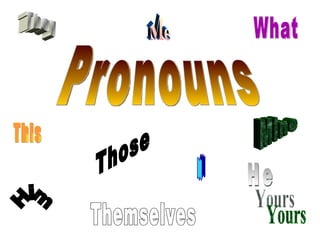Pronouns powerpoint
•Télécharger en tant que PPT, PDF•
147 j'aime•216,150 vues
Signaler
Partager
Signaler
Partager

Contenu connexe
Tendances (20)
En vedette
En vedette (20)
Personal Pronouns, Possessive Pronouns and Possessive Adjectives

Personal Pronouns, Possessive Pronouns and Possessive Adjectives
Similaire à Pronouns powerpoint
Similaire à Pronouns powerpoint (20)
Plus de caloughman
Plus de caloughman (11)
Dernier
Dernier (20)
Why Teams call analytics are critical to your entire business

Why Teams call analytics are critical to your entire business
Apidays New York 2024 - Accelerating FinTech Innovation by Vasa Krishnan, Fin...

Apidays New York 2024 - Accelerating FinTech Innovation by Vasa Krishnan, Fin...
Apidays New York 2024 - The Good, the Bad and the Governed by David O'Neill, ...

Apidays New York 2024 - The Good, the Bad and the Governed by David O'Neill, ...
Finding Java's Hidden Performance Traps @ DevoxxUK 2024

Finding Java's Hidden Performance Traps @ DevoxxUK 2024
How to Troubleshoot Apps for the Modern Connected Worker

How to Troubleshoot Apps for the Modern Connected Worker
Mcleodganj Call Girls 🥰 8617370543 Service Offer VIP Hot Model

Mcleodganj Call Girls 🥰 8617370543 Service Offer VIP Hot Model
TrustArc Webinar - Unlock the Power of AI-Driven Data Discovery

TrustArc Webinar - Unlock the Power of AI-Driven Data Discovery
Repurposing LNG terminals for Hydrogen Ammonia: Feasibility and Cost Saving

Repurposing LNG terminals for Hydrogen Ammonia: Feasibility and Cost Saving
Introduction to Multilingual Retrieval Augmented Generation (RAG)

Introduction to Multilingual Retrieval Augmented Generation (RAG)
Elevate Developer Efficiency & build GenAI Application with Amazon Q

Elevate Developer Efficiency & build GenAI Application with Amazon Q
Vector Search -An Introduction in Oracle Database 23ai.pptx

Vector Search -An Introduction in Oracle Database 23ai.pptx
Biography Of Angeliki Cooney | Senior Vice President Life Sciences | Albany, ...

Biography Of Angeliki Cooney | Senior Vice President Life Sciences | Albany, ...
WSO2's API Vision: Unifying Control, Empowering Developers

WSO2's API Vision: Unifying Control, Empowering Developers
Apidays New York 2024 - Passkeys: Developing APIs to enable passwordless auth...

Apidays New York 2024 - Passkeys: Developing APIs to enable passwordless auth...
Strategize a Smooth Tenant-to-tenant Migration and Copilot Takeoff

Strategize a Smooth Tenant-to-tenant Migration and Copilot Takeoff
Pronouns powerpoint
- 1. Pronouns He They Themselves What This Me Mine Yours Him I Those
- 3. Pronouns come in many different varieties.
- 5. singular plural 1 st person Personal nominative pronouns (also known as subject pronouns)--used as the subject of the sentence or the predicate pronoun also known as subjective case I you he, she, it they you we 2 nd person 3 rd person
- 6. singular plural 1 st person Personal objective pronouns--used as direct objects, indirect objects, or objects of prepositions me you him, her, it them you us 2 nd person 3 rd person
- 7. singular plural 1 st person Possessive pronouns—used to show ownership or relationship my, mine your, yours his, her, hers, its their, theirs your, yours our, ours 2 nd person 3 rd person
- 8. REFLEXIVE / INTENSIVE 1 st person myself, ourselves 2 nd person yourself, yourselves 3 rd person himself, herself, itself, themselves Hisself and theirselves are incorrect and should NEVER be used!
- 9. Since they have the same form . . . When are they reflexive? When are they intensive? Omit the pronoun. If the meaning of the sentence stays the same, the pronoun is intensive.
- 10. Mercedes designed the costume herself. intensive
- 11. Rover tried everything he could think of to free himself. reflexive
- 12. demonstrative pronouns—point out a particular person, place, thing, or idea that this these those
- 13. ! Example: This is my dog Penny. Example: That is my dog Guinness.
- 14. INTERROGATIVE PRONOUNS These pronouns are used to introduce questions.
- 16. Who? What? Whom? Which? Whose?
- 18. These pronouns replace nouns that are not specifically named.
- 19. SINGULAR INDEFINITE PRONOUNS another anybody anyone anything either everybody everyone everything neither nobody no one nothing somebody someone something each much one
- 20. PLURAL INDEFINITE PRONOUNS both few many several
- 21. INDEFINITE PRONOUNS SINGULAR OR PLURAL all any most none some
- 22. All the king’s horses . . .
- 24. A relative pronoun introduces a subordinate (dependent) clause. that which who whom whose
- 25. The red Ferrari is the one that I want .
- 26. What is an antecedent, and what does it have to do with pronouns?
- 27. An antecedent is the noun that the pronoun replaces.
- 28. Junior took his dog to the pet store and bought her a treat . He bought it because he loves her .